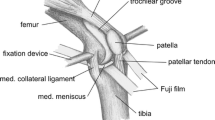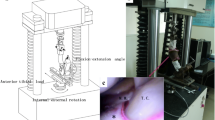Summary
Many investigators have attempted to find the cause of the osteoarthritic changes after meniscectomy. Alteration of the mechanical factors resulting in stress concentration, is now thought to be one of the most important causes but few experimental studies have reported the differences in contact area and pressure distribution after partial or total meniscectomy. By using pressure sensitive film, we have calculated the contact area and the pattern of weight distribution in three different situations; intact meniscus, partial and total meniscectomy. The experimental materials were obtained from 5 above knee amputation specimens. The knee joint was fixed in full extension to an Instron machine using an aluminium box and mounting resin. Load was transmitted to the tibiofemoral joint containing the special film, within a physiological range. Analysis of the contact area for each situation (intact meniscus, partial and total meniscectomy) was made by reviewing the film, By measuring the contact area after meniscectomy, we showed that the meniscus performs a load transmitting function in the knee joint. The medial contact area of the tibiofemoral joint with an intact meniscus is always larger than the lateral compartment (1.36:1), but in partial and total meniscectomy the difference between them gradually decreased. There was a minor decrease in contact area after partial meniscectomy and a much greater decrease after total meniscectomy. The degree of stress concentration in the contact area was increased when part or all the meniscus was excised. There was little change of contact area in the opposite, intact side of the joint after partial meniscectomy, but marked change after total meniscectomy.
Résumé
Nombre de travaux ont été effectués récemment afin d'expliquer l'évolution vers l'arthrose après méniscectomie. Les modifications mécaniques entraînant une concentration des contraintes sont considérées comme une des causes majeures. Mais il n'y a que peu d'études expérimentales concernant les différences de pression sur la surface de contact et le type de distribution des contraintes après méniscectomie partielle ou totale. En utilisant un film sensible à la pression (Pressensor) nous avons pu mesurer la surface de contact et son type de distribution dans les trois situations: ménisque intact, méniscectomie partielle et méniscectomie totale. Le matériel d'expérimentation consistait en cinq pièces d'amputation de cuisse. Pendant l'expérimentation le genou était placé en extension complète et fixé à la machine Instrom par une barre d'aluminium et une monture de résine. La charge était transmise par la machine à l'articulation fémoro-tibiale et au film Pressensor pré-inséré, dans les limites physiologiques. L'analyse de la surface de contact dans les trois situations a été permise par l'examen du film. En mesurant la surface de contact après méniscectomie nous avons montré que la fonction du ménisque est d'assurer la transmission des charges et l'absorption d'énergie dans le genou. La comparaison de la surface de contact interne de l'articulation avec la surface de contact externe montre que, lorsque le ménisque est intact, la première est toujours plus étendue que la seconde (le rapport est de 1.36). La différence diminue légérement en cas de méniscectomie partielle et beaucoup plus après méniscectomie totale. Le degré de concentration des contraintes augmente selon que le ménisque est intact, partiellement ou totalement réséqué. Il n'y a que de minimes modifications de la surface de contact du côté opposé de l'articulation après méniscectomie partielle, mais elles sont importantes après méniscectomie totale.
Similar content being viewed by others
References
Allen PR, Denham RA, Swan AV (1984) Late degenerative changes after meniscectomy. J Bone Joint Surg [Br]: 666–671
Baratz ME, Rehak DC, Fu FH, Rudert MJ (1988) Peripheral tears of the meniscus. Am J Sports Med 16: 1–6
Berjon JJ, Munuera L, Calvo M (1991) Degenerative lesions in the articular cartilage after meniscectomy: preliminary experimental study in dogs. J Trauma 31: 343–350
Cox JC, Ney CE, Schaefer WW, Woodstein IJ (1975) The degenerative effects of partial and total resection of medial meniscus in dog's knee. Clin Orthop 109: 178–183
Fairbank TJ (1948) Knee joint changes after meniscectomy. J Bone Joint Surg [Br] 30: 664–670
Ihn JC, Ahn MW, Kim DM (1989) Stress distribution on the tibio-femoral joint after meniscectomy. J Korean Orthop 24: 1553–1564
Johnson RJ, Kettelkamp DB, Clark W, Leaverton P (1974) Factors affecting late results after meniscectomy. J Bone Joint Surg [Am] 56: 719–729
Kettelkamp DB, Jacobs AW (1972) Tibiofemoral contact area determination and implications. J Bone Joint Surg [Am] 54: 349–356
King D (1936) The function of semilunar cartilage. J Bone Joint Surg [Am] 18: 1069–1076
Krause WR, Pope MH, Johnson RJ, Wilder DG (1976) Mechanical changes after meniscectomy. J Bone Joint Surg [Am] 58: 599–604
Lim HC, Lee SH, Shon WY, Lee DW, Na KW (1991) A X-ray and clinical study upon knee joint changes following surgical removal of discoid meniscus. J Korean Orthop 26: 41–48
Maquet PG, Van De Berg AJ, Simonet JC (1975) Femorotibial weight bearing area. J Bone Joint Surg [Am] 57: 766–771
Rudert MM, Baratz ME, Rehak DC, Fu FH (1988) Loading characteristics of pressensor. Transaction of the 34th Annual Meeting. Orthop Res Soc 1: 226–227
Seedhom (1979) Transmission of the load in the knee joint with special reference to the role of the menisci. Eng Med Imeche, vol B: 207–228
Smillie IS (1944) Observation on the regeneration of the semilunar cartilage in man. Br J Surg 31: 398–401
Tapper EM, Hoover NW (1969) Late results after meniscectomy. J Bone Joint Surg [Am] 51: 517–526
Walker PS, Hajek JV (1972) The load-bearing area in the knee joint. J Biomech 5: 581–589
Author information
Authors and Affiliations
Rights and permissions
About this article
Cite this article
Ihn, J.C., Kim, S.J. & Park, I.H. In vitro study of contact area and pressure distribution in the human knee after partial and total meniscectomy. International Orthopaedics 17, 214–218 (1993). https://doi.org/10.1007/BF00194181
Issue Date:
DOI: https://doi.org/10.1007/BF00194181




